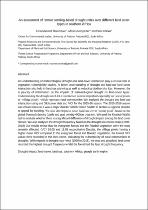 ResearchSpace
ResearchSpace
An assessment of remote sensing-based drought index over different land cover types in southern Africa
JavaScript is disabled for your browser. Some features of this site may not work without it.
- ResearchSpace
- →
- Research Publications/Outputs
- →
- Journal Articles
- →
- View Item
| dc.contributor.author |
Marumbwa, FM

|
|
| dc.contributor.author |
Cho, Moses A

|
|
| dc.contributor.author |
Chirwa, PW

|
|
| dc.date.accessioned | 2020-10-05T08:49:33Z | |
| dc.date.available | 2020-10-05T08:49:33Z | |
| dc.date.issued | 2020-07 | |
| dc.identifier.citation | Marumbwa, F.M., Cho, M.A. and Chirwa, P.W. 2020. An assessment of remote sensing-based drought index over different land cover types in southern Africa. International Journal of Remote Sensing, v41(19), pp 7368-7382. | en_US |
| dc.identifier.issn | 0143-1161 | |
| dc.identifier.issn | 1366-5901 | |
| dc.identifier.uri | https://www.tandfonline.com/doi/full/10.1080/01431161.2020.1757783 | |
| dc.identifier.uri | https://doi.org/10.1080/01431161.2020.1757783 | |
| dc.identifier.uri | http://hdl.handle.net/10204/11588 | |
| dc.description | Copyright: 2020 Taylor & Francis. This is the preprint version of the work. For access to the published version, kindly visit the publisher's website. | en_US |
| dc.description.abstract | An understanding of drought and land cover interaction plays a crucial role in vegetation vulnerability studies and land use planning. However, there is paucity of information on drought, land cover and land use interaction in southern Africa. We analysed the drought impact on land cover using Globcover land cover data and Vegetation Condition Index (VCI) for the 2015 to 2016 season. The 2015 to 2016 season was chosen because it was the worst drought in southern Africa since the 1980s. We developed a novel land cover social pixels’ or ‘village pixels’ which represents rural communities. The Kruskal–Wallis test was used to evaluate whether there is a significant difference in drought impact among the land cover classes. The response of each land cover to drought impact was calculated by correlating Standardized Precipitation Evapotranspiration Index (SPEI) and Normalized Difference Vegetation Index (NDVI). Our results reveal that the evergreen forests and the flooded vegetation were the most severely affected by the 2015–2016 drought. However, the lowest VCI values were recorded within the village pixels land cover, indicating the vulnerability of rural communities to drought impacts. The vegetation response to drought impact ranged from 2 months (crops) to 8 months (flooded vegetation). With regards to drought recurrence (1998 to 2018), the crop and grassland land cover recorded the highest drought frequency whilst the forest had the least drought frequency. | en_US |
| dc.language.iso | en | en_US |
| dc.publisher | Taylor & Francis | en_US |
| dc.relation.ispartofseries | Worklist;23730 | |
| dc.subject | Drought | en_US |
| dc.subject | Land use | en_US |
| dc.subject | Land cover | en_US |
| dc.title | An assessment of remote sensing-based drought index over different land cover types in southern Africa | en_US |
| dc.type | Article | en_US |
| dc.identifier.apacitation | Marumbwa, F., Cho, M. A., & Chirwa, P. (2020). An assessment of remote sensing-based drought index over different land cover types in southern Africa. http://hdl.handle.net/10204/11588 | en_ZA |
| dc.identifier.chicagocitation | Marumbwa, FM, Moses A Cho, and PW Chirwa "An assessment of remote sensing-based drought index over different land cover types in southern Africa." (2020) http://hdl.handle.net/10204/11588 | en_ZA |
| dc.identifier.vancouvercitation | Marumbwa F, Cho MA, Chirwa P. An assessment of remote sensing-based drought index over different land cover types in southern Africa. 2020; http://hdl.handle.net/10204/11588. | en_ZA |
| dc.identifier.ris | TY - Article AU - Marumbwa, FM AU - Cho, Moses A AU - Chirwa, PW AB - An understanding of drought and land cover interaction plays a crucial role in vegetation vulnerability studies and land use planning. However, there is paucity of information on drought, land cover and land use interaction in southern Africa. We analysed the drought impact on land cover using Globcover land cover data and Vegetation Condition Index (VCI) for the 2015 to 2016 season. The 2015 to 2016 season was chosen because it was the worst drought in southern Africa since the 1980s. We developed a novel land cover social pixels’ or ‘village pixels’ which represents rural communities. The Kruskal–Wallis test was used to evaluate whether there is a significant difference in drought impact among the land cover classes. The response of each land cover to drought impact was calculated by correlating Standardized Precipitation Evapotranspiration Index (SPEI) and Normalized Difference Vegetation Index (NDVI). Our results reveal that the evergreen forests and the flooded vegetation were the most severely affected by the 2015–2016 drought. However, the lowest VCI values were recorded within the village pixels land cover, indicating the vulnerability of rural communities to drought impacts. The vegetation response to drought impact ranged from 2 months (crops) to 8 months (flooded vegetation). With regards to drought recurrence (1998 to 2018), the crop and grassland land cover recorded the highest drought frequency whilst the forest had the least drought frequency. DA - 2020-07 DB - ResearchSpace DP - CSIR KW - Drought KW - Land use KW - Land cover LK - https://researchspace.csir.co.za PY - 2020 SM - 0143-1161 SM - 1366-5901 T1 - An assessment of remote sensing-based drought index over different land cover types in southern Africa TI - An assessment of remote sensing-based drought index over different land cover types in southern Africa UR - http://hdl.handle.net/10204/11588 ER - | en_ZA |





